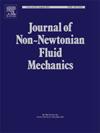Inelastic fluid models with an objective stretch rate parameter
IF 2.8
2区 工程技术
Q2 MECHANICS
引用次数: 0
Abstract
This paper presents an extension to the Generalized Newtonian Fluid (GNF) model, where the effects of different flow modes can be discerned. While existing GNF models have proven valuable in simulating processes like molding and extrusion, they often struggle to differentiate between distinct flow modes such as planar extension and simple shear. To address this challenge, we propose a modified GNF model that integrates an objective flow-type parameter, aiming to refine flow characterization. Emphasis is placed on defining the flow-type parameter to be able to transcend viscometric flows, remain frame-indifferent, quantify deformation magnitude, and differentiate between diverse flow modes. Inspired by the new advances in vortex identification in turbulent flow, we introduce a new stretch rate tensor and a new stretch rate parameter that are derived from the real Schur form of the objective velocity gradient tensor. These elements are embedded into the constitutive modeling of non-Newtonian fluid flow. The resulting model is employed to fit polymer melt data from the literature, demonstrating excellent fitting to combined shear and extension data. The basic model uses 5 to 6 parameters for data fitting, and further enhancement may be achieved by incorporating other extracted information of the stretch rate tensor.
具有客观拉伸率参数的非弹性流体模型
本文介绍了广义牛顿流体(GNF)模型的扩展,在该模型中,可以辨别不同流动模式的影响。虽然现有的 GNF 模型在模拟成型和挤压等过程中已被证明很有价值,但它们往往难以区分平面延伸和简单剪切等不同的流动模式。为了应对这一挑战,我们提出了一种改进的 GNF 模型,该模型集成了一个客观的流动类型参数,旨在完善流动特征描述。重点在于定义流动类型参数,使其能够超越粘性流动,保持框架无关性,量化变形幅度,并区分不同的流动模式。受湍流中涡流识别新进展的启发,我们引入了一个新的拉伸率张量和一个新的拉伸率参数,它们来自客观速度梯度张量的实舒尔形。这些元素被嵌入到非牛顿流体流动的构成模型中。由此产生的模型用于拟合文献中的聚合物熔体数据,显示出与剪切和拉伸综合数据的出色拟合。基本模型使用 5 到 6 个参数进行数据拟合,并可通过加入拉伸率张量的其他提取信息进一步提高拟合效果。
本文章由计算机程序翻译,如有差异,请以英文原文为准。
求助全文
约1分钟内获得全文
求助全文
来源期刊
CiteScore
5.00
自引率
19.40%
发文量
109
审稿时长
61 days
期刊介绍:
The Journal of Non-Newtonian Fluid Mechanics publishes research on flowing soft matter systems. Submissions in all areas of flowing complex fluids are welcomed, including polymer melts and solutions, suspensions, colloids, surfactant solutions, biological fluids, gels, liquid crystals and granular materials. Flow problems relevant to microfluidics, lab-on-a-chip, nanofluidics, biological flows, geophysical flows, industrial processes and other applications are of interest.
Subjects considered suitable for the journal include the following (not necessarily in order of importance):
Theoretical, computational and experimental studies of naturally or technologically relevant flow problems where the non-Newtonian nature of the fluid is important in determining the character of the flow. We seek in particular studies that lend mechanistic insight into flow behavior in complex fluids or highlight flow phenomena unique to complex fluids. Examples include
Instabilities, unsteady and turbulent or chaotic flow characteristics in non-Newtonian fluids,
Multiphase flows involving complex fluids,
Problems involving transport phenomena such as heat and mass transfer and mixing, to the extent that the non-Newtonian flow behavior is central to the transport phenomena,
Novel flow situations that suggest the need for further theoretical study,
Practical situations of flow that are in need of systematic theoretical and experimental research. Such issues and developments commonly arise, for example, in the polymer processing, petroleum, pharmaceutical, biomedical and consumer product industries.

 求助内容:
求助内容: 应助结果提醒方式:
应助结果提醒方式:


